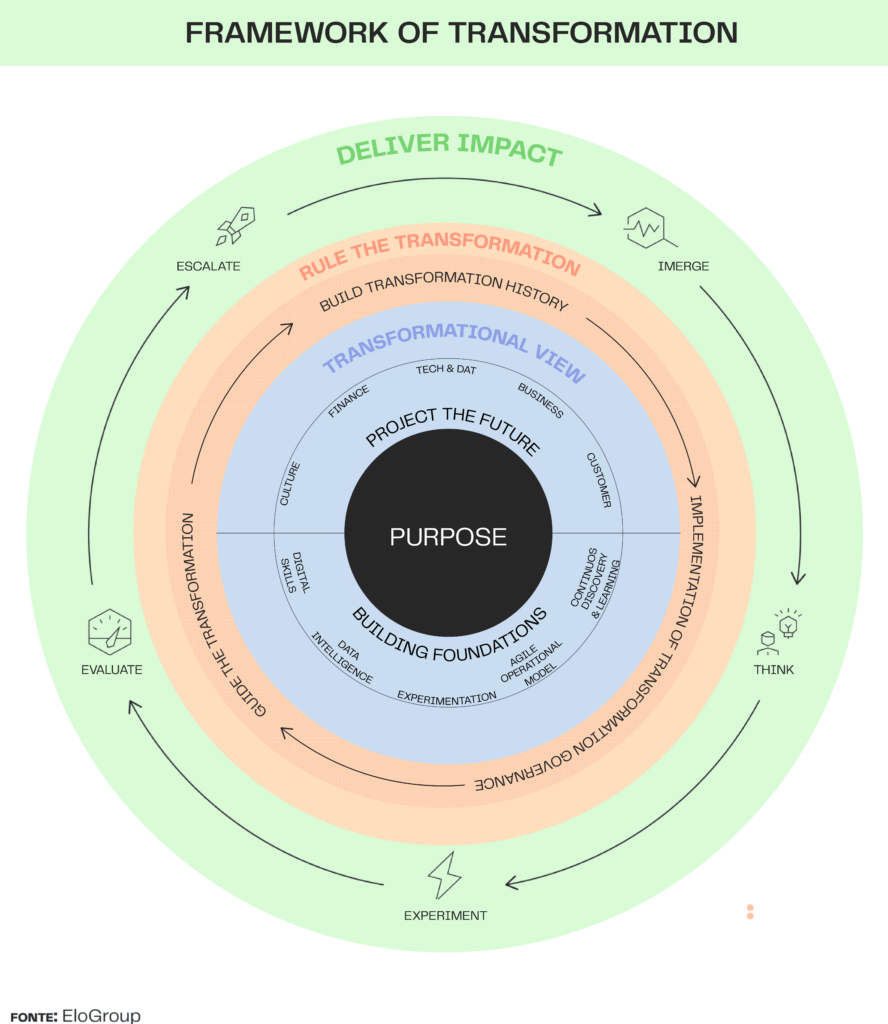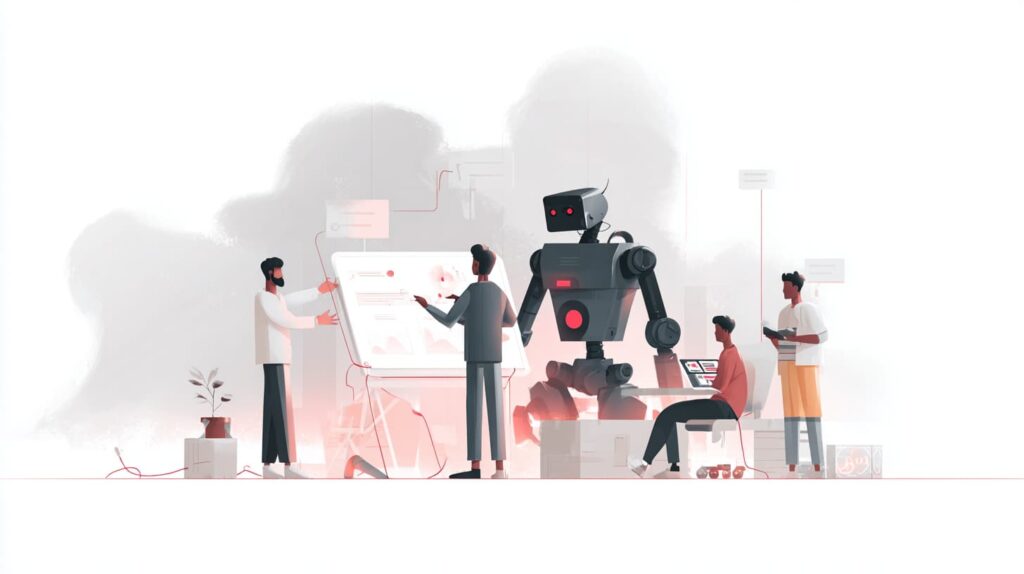By EloInsights, in collaboration with Marcos Navarini
- In a transformation journey, delivering and measuring impact are essential steps.
- The Design Thinking approach brings tools to unlock this part of the transformation journey.
- The application of agile method principles, such as short implementation windows and feedback, helps to unlock a culture of experimentation and team independence when testing hypotheses.
This is the third in a series of four articles on the Transformation Battles that will be published in EloInsights.
In the first two articles in this series on the Great Battles of an organization’s Transformation, we covered everything from the importance of projecting the future to the role of setting up governance that can support people, driving processes and helping to implement technological tools to overcome different business challenges, in a cycle of constant renewal.
Now let’s focus on another essential part of this process: delivering and measuring the impact of the transformation.
Although the entire process of changing an organization is complex and requires patience, it is also important to make it possible to collect the first fruits quickly, to ensure that the movement gains traction and does not lose momentum.
In this instalment, we will cover the principles of Design Thinking and the tools that ease each of its stages. We will also explore the importance of implementing elements of the agile method to shorten delivery windows, enabling more constant feedback, in a continuous cycle that promotes stakeholder engagement by offering tangible results even before the transformation is complete.
The starting point will be the stages described in EloGroup’s transformation framework in its impact delivery layer, based on the Design Thinking model: immersion, ideation, experimentation, evaluation and scaling up. We also highlight some of the main mistakes made in this part of the transformation journey.

Design Thinking: delivery stages and impact measurement
Immersion involves going deeper into the reality of the client, whether internal or external, and “empathy” is one of the key words. It involves mapping information, stakeholders, conducting research, group and individual interviews and putting yourself in the user’s shoes, minimizing barriers to offer a more holistic view of the problems that need to be solved.
In ideation, tools such as brainstorming and benchmarking help to create hypotheses to be tested in the following stages. It is important here that there is no judgement, that unusual ideas are encouraged, and that those involved focus on the essence of the proposals, without getting lost in details that could hinder the evolution of this phase.
Experimentation and evaluation are related to testing the hypotheses raised at the earlier stage, and here principles such as “learn to burn” come into play, which sets up the importance of learning (and making mistakes) while spending the least amount of resources possible.
The creation of MVPs (minimally viable products) is also part of the menu of tools that help validate hypotheses that can lead to the solution of problems faced by users. Ultimately, the aim is to consolidate a perennial culture of experimentation that encompasses the entire organization.
Finally, in the last stage of this circular and perpetual process, the participants in the transformation process must choose, based on the results of the experiments, which solutions should be scaled up and expanded to a wider scope within the organization, and which should be discarded.
Successful transformations must be disciplined and linked to ambitious goals – which are organized within a macro strategy – measured by clear metrics and linked to financial results. Each challenge must be tackled by multidisciplinary teams that not only generate constant deliveries but are also extremely focused on collecting feedback from their customers.
Below, we analyze some of the main mistakes in the delivery and impact measurement stage of a transformation process.
Mistake 1: Focusing on the process and not the customer
The needs of customers, whether internal or external, must always be the focus during a transformation process. In this context, it is vital to adopt continuous discovery practices, which will allow insights to be gathered and opportunities associated with the purpose of the transformation to be identified.
In other words, the process is initiated and driven by the ability to identify and articulate problems through deep immersion in the client’s context. Seeing, living, listening and feeling like the customer in the best viable way is an essential step in designing successful solutions.
Tim Brown, CEO of IDEO and one of the great names in Design Thinking, in his book Change by Design, summarizes these techniques in the stages of insight, observation and empathy:
- Learn about the user’s reality. The customers of this transformation will rarely tell you what they need and, if asked directly, their answer will probably be based on their current, biased reality. That is why the role of the transformation is to create context, to delve into reality, to study and learn about the user’s problems through different lenses. At this point, market research, group and individual interviews are useful tools to help with the process.
- Observe what they do (and do not do). The concrete knowledge lies in the day-to-day life of the customer on the other side of the transformation. Whether it is the executor of an internal process or the user journey of a product, there are human beings involved. To do this, it is vital to go where they are and talk to them, reducing guesswork and assumptions, in a process that author Steve Blank calls “get out of the building”. Only then can you answer: which of your pains are latent? How does he make decisions along his journey?
- Create empathy. Experience the user’s daily life in full, minimizing research barriers and creating context for decision-making in the transformation. Techniques such as the “hidden client” or “a day in the life” bring the experience to the center of the transformation, connecting those who design the solutions to reality and all its particularities.
Mistake 2: Working with long planning and investment cycles
During a transformation process, long cycles can do a lot of damage, mainly by reducing visibility of the result, making it difficult to test hypotheses and “strangling” the feedback cycle on the teams’ achievements along the way. That is why investing in agile models that can shorten delivery windows and enabling a continuous delivery flow is the “antidote” to this problem.
- It is important to realize, however, that not every project will adapt to an agile model, especially in the context of projects with high stability, well-defined deliveries and schedules, where more traditional approaches, such as the waterfall approach, are commonly used. The important thing is that the different models coexist fluidly, allowing teams working in unusual ways to interact and co-operate.
- Iterations in a short space of time, in which a section of work is carried out and tested, can be considered fundamental elements of an agile development approach. This enables regular, continuous deliveries, which allows for the collection of feedback and better visibility of the result throughout the transformation process, as well as minimizing risks with the possibility of adjustments before the solution is scaled up to a wider scope.
- Experiment, and eventually fail with speed. Define a drumbeat (or rhythm of execution) that translates into constant deliveries, in a flow that enables continuous learning and the possibility of correcting routes. In this process, it will be vital to create technological and procedural enablers, such as an architecture that enables deployment in a short space of time, as well as experiments.
- Create feedback loops; mechanisms that allow customer impressions to be collected, absorbed and disseminated by the team involved in the transformation. This highlights the importance of creating context and using it to refine the team’s work.
Mistake 3: Cultivating rigid hierarchies and organizational silos
A logic of command and control, with rigid hierarchies and organizational silos, hinders the culture of experimentation and compromises the continuous cycle of transformation, which strongly depends on this dynamic of constant testing of hypotheses and relative independence of teams, even if they are guided by clear communication of the organization’s vision and strategy from the leadership.
In this context, we highlight some of the key elements to enable empowerment at the top and greater organizational horizontality:
- Multidisciplinary teams provide a greater variety of views on user problems and autonomy guarantees more creativity and agility, as well as a healthier way of dealing with the natural interdependence of teams, even though the challenge of moving in a unified way is relevant. The need for alignment is often tackled by applying agility models at scale, such as SAFe.
- Empowering teams to act autonomously creates horizontality and enriches decision-making. Authors such as Marty Cagan, of Empowered – Ordinary People Extraordinary Products, emphasize the importance of creating conditions in which employees can own end-to-end missions.
- We need to design a logic of accountability, where teams can align themselves with the organization’s strategy and vision, communicated by the leadership, without depending on constant approvals, even if there is occasional monitoring. In this scenario, teams take ownership of their part in the strategy, aligned with clear success metrics.
- Transformation carried out in an agile way requires not only agility in the teams, but also agility at an organizational level. For example, the “flight levels” model proposed by author Klaus Leopold helps us think about how the different teams relate to each other in a three-level approach that ranges from the most operational (backlog management at team level), through coordination (the alignment of backlogs and their interdependencies), to strategic portfolio management (the breakdown of strategy into objectives and targets).
Mistake 4: Equating delivery with impact
Delivery and impact are different things. Impact is the gain or result extracted from a process after a set of deliveries. Taking a transformation in an organization’s finance department as an example, a possible impact would be the gain in agility in its processes, which results in resource savings, after the transformation – a result obtained through a series of earlier deliveries.
In a transformation process, it is important to use metrics that prove success, not just deliverables. Aligning with leadership expectations involves establishing goals and key results, and the following points help to deepen this understanding:
- We can also look at the difference between result and delivery from the perspective of output and outcome. The first, output, refers to a delivery, without necessarily translating into value. For example, the implementation of a new feature in an application. The second, outcome, refers to the value and impact brought about by this output. Following the same example, the outcome of implementing a new feature could be an improvement in the application’s usability for users. We can also talk about business impact, a third moment in this chain of events, which would be, for example, an increase in the number of downloads of that app, because of the improved usability.
- When it comes to measuring impact, one example is the application of the OKRs (Objectives and Key Results) methodology; this is one of the instruments that helps keep the transformation moving in the right direction, since it establishes concrete strategic objectives that are relevant to the organization, while progress towards the objectives can be measured on the basis of a set of key results, or outcomes. Within the logic of experimentation, OKRs make it possible to evaluate and calibrate the expectations of leaders, as well as having a significant effect on convincing and getting stakeholders on board. It increases both the engagement of those who are interested in checking the process and the motivation of those who are involved in executing it.
In the next article, we will look at the fourth Battle of Transformation: how to build the foundations for continuous change.
MARCOS NAVARINI works as Senior Consultant and Digital Lab Leader at EloGroup.











